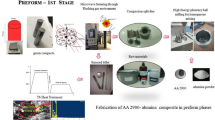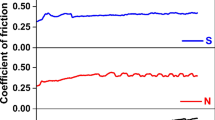Abstract
The aim of this research was to develop a lightweight, asbestos-free brake friction material using sisal, jute, and sisal/jute hybrid composites along with fillers and frictional additives. Sisal, jute, and sisal/jute hybrid fiber–reinforced epoxy polymer-filler-based composites were prepared using a compression molding process, and their mechanical and tribological properties were evaluated as per ASTM standards. The results were compared with commercial brake friction material. The study found that the compressive strength of sisal, jute, and hybrid composites increased by 21%, 11.6%, and 16.65%, respectively, while the hybrid composite (S3 + J3) exhibited nearly equivalent compressive strength. The impact strength, hardness, and water and oil absorption behavior of the hybrid composite exhibited the same performance as that of commercial brake pads. A pin-on-disc experiment was conducted and the results showed that wear loss and coefficient of friction decreased with an increased weight percentage of fiber. Scanning electron microscopy images depicted uniform dispersion, distribution, and defect-free laminates with a uniform wear track. Overall results suggest the potential use of these composites in brake pad applications. Therefore, this study presents the development of sisal-jute fiber epoxy filler–based hybrid composites for lightweight applications, which can be used as a substitute for asbestos in brake pads.











Similar content being viewed by others
Data availability
Not applicable.
References
Yang W, Liu J, Zhou K, Zhang Z, Qu X (2020) An automatic emergency braking model considering Driver’s intention recognition of the front vehicle. J Adv Transp 2020:1–15
Yavuz H (2023) Effect of limestone usage on tribological properties in copper and asbestos-free brake friction materials. Ind Lubr Tribol 75(2):238–245
Hee KW, Filip P (2005) Performance of ceramic enhanced phenolic matrix brake lining materials for automotive brake linings. Wear 259(7–12):1088–1096
Silverstein MA, Welch LS, Lemen R (2009) Developments in asbestos cancer risk assessment. Am J Ind Med 52(11):850–858
Kumar VV, Kumaran SS (2019) Friction material composite: types of brake friction material formulations and effects of various ingredients on brake performance–a review. Mater Res Express 6(8):082005
Chan DSEA, Stachowiak GW (2004) Review of automotive brake friction materials. Proc Inst Mech Eng, Part D: J Automob Eng 218(9):953–966
Ganguly A, George R (2008) Asbestos free friction composition for brake linings. Bull Mater Sci 31(1):19–22
Rao RU, Babji G (2015) A Review paper on alternate materials for asbestos brake pads and its characterization. Int Res J Eng Technol 2(2):556–562
Idris UD, Aigbodion VS, Abubakar IJ, Nwoye CI (2015) Eco-friendly asbestos free brake-pad: using banana peels. J King Saud Univ-Eng Sci 27(2):185–192
Aranganathan N, Bijwe J (2016) Development of copper-free eco-friendly brake-friction material using novel ingredients. Wear 352:79–91
Zhang H, Zhang Z, Friedrich K (2007) Effect of fiber length on the wear resistance of short carbon fiber reinforced epoxy composites. Compos Sci Technol 67(2):222–230
Bijwe J, Kumar M, Gurunath PV, Desplanques Y (2008) Optimization of brass contents for best combination of tribo-performance and thermal conductivity of non-asbestos organic (NAO) friction composites. Wear 265(5–6):699–712
Elakhame ZU, Alhassan OA, Samuel AE (2014) Development and production of brake pads from palm kernel shell composites. Int J Sci Eng Res 5(10):735–744
Ilanko AK, Vijayaraghavan S (2016) Wear behavior of asbestos-free eco-friendly composites for automobile brake materials. Friction 4:144–152
Olabisi AI, Adam AN, Okechukwu OM (2016) Development and assessment of composite brake pad using pulverized cocoa beans shells filler. Int J Mater Sci Appl 5(2):66–78
Mohit H, Rangappa SM, Gapsari F, Siengchin S, Marwani HM, Khan A, Asiri AM (2023) Effect of bio-fibers and inorganic fillers reinforcement on mechanical and thermal characteristics on carbon-kevlar-basalt-innegra fiber bio/synthetic epoxy hybrid composites. J Market Res 23:5440–5458
Gapsari F, Putri TM, Juliano H, Djakfar L, Handajani RP, Budio SP, Juwono PT, Jagadeesh P, Mavinkere Rangappa S, Siengchin S (2022) Influence of calcium carbonate fillers on pine fiber reinforced polyester composites. Polym Compos 43(7):4306–4317
Puttegowda M, Rangappa SM, Khan A, Al-Zahrani SA, Al Otaibi A, Shivanna P, Moure MM, Siengchin S (2020) Preparation and characterization of new hybrid polymer composites from phoenix pusilla fibers/e-glass/carbon fabrics on potential engineering applications: Effect of stacking sequence. Polym Compos 41(11):4572–4582
Moure MM, Rubio I, Aranda-Ruiz J, Loya JA, Rodríguez-Millán M (2018) Analysis of impact energy absorption by lightweight aramid structures. Compos Struct 203:917–926
Bharath KN, Madhu P, Gowda TY, Verma A, Sanjay MR, Siengchin S (2021) Mechanical and chemical properties evaluation of sheep wool fiber–reinforced vinylester and polyester composites. Mater Perform Charact 10(1):99–109
Bharath KN, Madhu P, Gowda TG, Verma A, Sanjay MR, Siengchin S (2020) A novel approach for development of printed circuit board from biofiber based composites. Polym Compos 41(11):4550–4558
Arpitha GR, Sanjay MR, Senthamaraikannan P, Barile C, Yogesha B (2017) Hybridization effect of sisal/glass/epoxy/filler based woven fabric reinforced composites. Exp Tech 41:577–584
Sanjay MR, Yogesha B (2018) Studies on hybridization effect of jute/kenaf/E-glass woven fabric epoxy composites for potential applications: effect of laminate stacking sequences. J Ind Text 47(7):1830–1848
Kumar AJ, Ramaseshan NA, Lakshmanan T (2021) Tribological analysis on basalt/aramid hybrid fiber reinforced polyimide composites: an alternate brake pad material. Tribol Ind 43(2):334
Kumar N, Singh T, Grewal JS, Patnaik A, Fekete G (2019) Experimental investigation on the physical, mechanical and tribological properties of hemp fiber-based non-asbestos organic brake friction composites. Mater Res Express 6(8):085710
Yashas Gowda TG, Vinod A, Madhu P, Sanjay MR, Siengchin S, Jawaid M (2022) Areca/synthetic fibers reinforced based epoxy hybrid composites for semi-structural applications. Polym Compos 43(8):5222–5234
Straffelini G, Ciudin R, Ciotti A, Gialanella S (2015) Present knowledge and perspectives on the role of copper in brake materials and related environmental issues: a critical assessment. Environ Pollut 207:211–219
Abdollah MFB, Shuhimi FF, Ismail N, Amiruddin H, Umehara N (2015) Selection and verification of kenaf fibres as an alternative friction material using Weighted Decision Matrix method. Mater Des 67:577–582
Athith D, Sanjay MR, Yashas Gowda TG, Madhu P, Arpitha GR, Yogesha B, Omri MA (2018) Effect of tungsten carbide on mechanical and tribological properties of jute/sisal/E-glass fabrics reinforced natural rubber/epoxy composites. J Ind Text 48(4):713–737
Bijwe J (2007) NBR-modified resin in fade and recovery module in non-asbestos organic (NAO) friction materials. Tribol Lett 27:189–196
Shin MW, Cho KH, Lee WK, Jang H (2010) Tribological characteristics of binder resins for brake friction materials at elevated temperatures. Tribol Lett 38:161–168
Jothibasu S, Mohanamurugan S, Vijay R, Lenin Singaravelu D, Vinod A, Sanjay MR (2020) Investigation on the mechanical behavior of areca sheath fibers/jute fibers/glass fabrics reinforced hybrid composite for light weight applications. J Ind Text 49(8):1036–1060
Ganesan K, Kailasanathan C, Sanjay MR, Senthamaraikannan P, Saravanakumar SS (2020) A new assessment on mechanical properties of jute fiber mat with egg shell powder/nanoclay-reinforced polyester matrix composites. J Nat Fibers 17:482–490
Sanjay MR, Arpitha GR, Senthamaraikannan P, Kathiresan M, Saibalaji MA, Yogesha B (2019) The hybrid effect of Jute/Kenaf/E-glass woven fabric epoxy composites for medium load applications: impact, inter-laminar strength, and failure surface characterization. J Nat Fibers 16(4):600–612
Yorseng K, Rangappa SM, Parameswaranpillai J, Siengchin S (2022) Towards green composites: bioepoxy composites reinforced with bamboo/basalt/carbon fabrics. J Clean Prod 363:132314
Joo BS, Chang YH, Seo HJ, Jang H (2019) Effects of binder resin on tribological properties and particle emission of brake linings. Wear 434:202995
Jafari SH, Fallahzadeh F, Rana SK (1999) Effect of post-curing on frictional behaviour of non-woven phenolic composite in automobile clutch facing. Iran Polym J 8:143–148
Hentati N, Kchaou M, Cristol AL, Najjar D, Elleuch R (2014) Impact of post-curing duration on mechanical, thermal and tribological behavior of an organic friction material. Mater Des 63:699–709
Nesrine H, Cristol AL, Najjar D, Elleuch R, Desplanques Y (2014) Influence of hot molding parameters on tribological and wear properties of a friction material. Tribol Trans 57(3):387–395
Raj SS, Kuzmin AM, Subramanian K, Sathiamoorthyi S, Kandasamy KT (2021) Philosophy of selecting ASTM standards for mechanical characterization of polymers and polymer composites. Materiale Plastice 58(3):247–256
Ramesh M, Palanikumar K, Hemachandra Reddy K (2016) Evaluation of mechanical and interfacial properties of sisal/jute/glass hybrid fiber reinforced polymer composites. Trans Indian Inst Met 69(10):1851–1859
Yorseng K, Rangappa SM, Pulikkalparambil H, Siengchin S, Parameswaranpillai J (2020) Accelerated weathering studies of kenaf/sisal fiber fabric reinforced fully biobased hybrid bioepoxy composites for semi-structural applications: morphology, thermo-mechanical, water absorption behavior and surface hydrophobicity. Constr Build Mater 235:117464
Dinesh S, Kumaran P, Mohanamurugan S, Vijay R, Singaravelu DL, Vinod A, Sanjay MR, Siengchin S, Bhat KS (2020) Influence of wood dust fillers on the mechanical, thermal, water absorption and biodegradation characteristics of jute fiber epoxy composites. J Polym Res 27:1–13
Ngaowthong C, Borůvka M, Běhálek L, Lenfeld P, Švec M, Dangtungee R, Siengchin S, Rangappa SM, Parameswaranpillai J (2019) Recycling of sisal fiber reinforced polypropylene and polylactic acid composites: thermo-mechanical properties, morphology, and water absorption behavior. Waste Manage 97:71–81
Mishra SK, Dahiya S, Gangil B, Ranakoti L, Singh T, Sharma S, Boonyasopon P, Rangappa SM, Siengchin S (2022) Mechanical, morphological, and tribological characterization of novel walnut shell-reinforced polylactic acid-based biocomposites and prediction based on artificial neural network. Biomass Convers Biorefinery 1–12
Jenish I, Veeramalai Chinnasamy SG, Basavarajappa S, Indran S, Divya D, Liu Y, Sanjay MR, Siengchin S (2022) Tribo-Mechanical characterization of carbonized coconut shell micro particle reinforced with Cissus quadrangularis stem fiber/epoxy novel composite for structural application. Journal of Natural Fibers 19(8):2963–2979
Funding
Not applicable.
Author information
Authors and Affiliations
Contributions
All authors are equally contributed to conceptualization; methodology; writing—original draft; writing—review and editing.
Corresponding author
Ethics declarations
Ethics approval
The authors hereby state that the present work is in compliance with the ethical standards.
Consent to participate
Not applicable.
Competing interests
The authors declare no competing interests.
Additional information
Publisher's note
Springer Nature remains neutral with regard to jurisdictional claims in published maps and institutional affiliations.
Rights and permissions
Springer Nature or its licensor (e.g. a society or other partner) holds exclusive rights to this article under a publishing agreement with the author(s) or other rightsholder(s); author self-archiving of the accepted manuscript version of this article is solely governed by the terms of such publishing agreement and applicable law.
About this article
Cite this article
Manjulaiah, H., Dhanraj, S., Basavegowda, Y. et al. A novel study on the development of sisal-jute fiber epoxy filler–based composites for brake pad application. Biomass Conv. Bioref. (2023). https://doi.org/10.1007/s13399-023-04219-4
Received:
Revised:
Accepted:
Published:
DOI: https://doi.org/10.1007/s13399-023-04219-4




